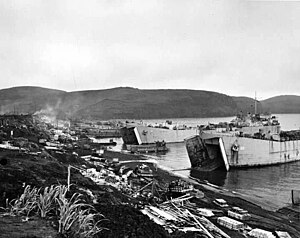

| Operation Cottage | |||||||
|---|---|---|---|---|---|---|---|
| Part of the Aleutian Islands campaignofWorld War II | |||||||
 American troops landing on Kiska | |||||||
| |||||||
| Belligerents | |||||||
|
|
| ||||||
| Commanders and leaders | |||||||
|
| Not present | ||||||
| Units involved | |||||||
| None present | ||||||
| Strength | |||||||
|
| Sea mines, mines, booby traps | ||||||
| Casualties and losses | |||||||
|
92 killed[1] 221 wounded Landing forces: 32 killed[2] 100 wounded U.S Navy: 1 destroyer (USS Abner Read) heavily damaged 71 killed 47 wounded | None | ||||||
Operation Cottage was a tactical maneuver which completed the Aleutian Islands campaign. On August 15, 1943, Allied military forces landed on Kiska Island, which had been occupied by Japanese forces since June 1942. However, the Japanese had secretly abandoned the island two weeks earlier, and so the Allied landings were unopposed. Allied forces suffered over 500 casualties in total during the operation from Japanese landmines and booby traps, friendly fire incidents, and vehicle accidents.[1][3]
The Japanese under Captain Takeji Ono had landed on Kiska on June 6, 1942 with 500 troops of Special Naval Landing Forces. Soon after arrival, they stormed an American weather station, where they killed two and captured eight United States Navy officers. The captured officers were sent to Japan as prisoners of war. Another 2,000 Japanese troops arrived, landing in Kiska Harbor. At this time, Rear Admiral Monzo Akiyama headed the force on Kiska. In December 1942, additional anti-aircraft units, engineers, and a negligible number of reinforcement infantry arrived on the island. In the spring of 1943, control was transferred to Lt. General Kiichiro Higuchi.[citation needed]

After the heavy casualties suffered at Attu Island, Japanese planners were expecting another costly operation. They realized the isolated Kiska Island was no longer defensible and planned for an evacuation.[citation needed] Starting in late July, there were increasing signs of Japanese withdrawal. Aerial photograph analysts noticed that routine activities appeared to greatly diminish, and almost no movement could be detected in the harbor. Bomb damage appeared unrepaired, and aircrews reported greatly diminished anti-aircraft fire. On July 28, 1943, radio signals from Kiska ceased entirely.[citation needed]
On August 15, 1943, the U.S. 7th Infantry Division, 87th Mountain Infantry Regiment of the 10th Mountain Division and the 13th Canadian Infantry Brigade from the 6th Canadian Infantry Division, landed on opposite shores of Kiska. Canadian regiments landed included the Canadian Fusiliers; the Winnipeg Grenadiers; the Rocky Mountain Rangers; and the Saint John Fusiliers. The invasion also involved the first combat deployment of the First Special Service Force, an elite special forces unit consisting of American and Canadian commandos.[3]
Both U.S. and Canadian forces mistook each other, after a Canadian soldier shot at U.S. lines believing they were Japanese, and a friendly fire incident occurred, which left 28 Americans and 4 Canadians dead, with 50 wounded on either side. Progress was also hampered by mines, timed bombs, accidental ammunition detonations, vehicle accidents and booby traps that caused further casualties.[2] A stray Japanese sea mine caused the USS Abner Read (DD-526) to lose a large chunk of its stern. The blast killed 71 and wounded 47 personnel.[3]
|
The USS Pennsylvania bombards Attu during landing operations of 11 May 1943
Aerial photo of a U.S. Army Air Forces bombardment on Kiska Island in 1942.
Aerial reconnaissance photo of the Japanese-held Aleutian Island of Kiska, taken in 1943.
Japanese transport ship burning off Kiska, Alaska after U.S. attack on 18 June 1942
Troops march up the beach at Adak, during pre-invasion loading for the Kiska Operation, 13 August 1943
Ventura planes patrol skies during the initial Allied landing on Kiska Island
U.S Soldiers getting off their landing craft onto the rocky shores of Kiska Island
Allied Landing on Kiska Island
|
Originally Published in Esprit de Corp Magazine, Volume 9 Issue 4 and Volume 9 Issue 5
|
| |||
|---|---|---|---|
| Timeline of Alaska |
|
|
| Topics and events |
| ||